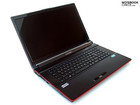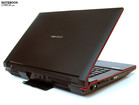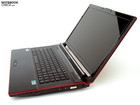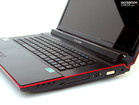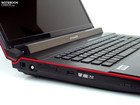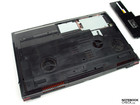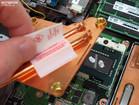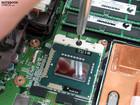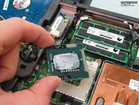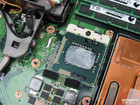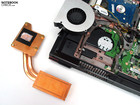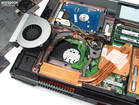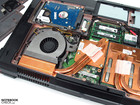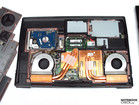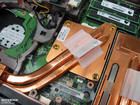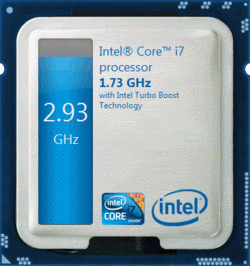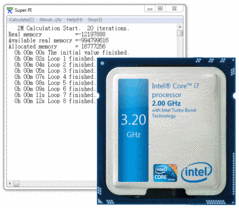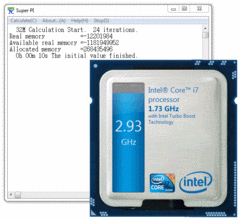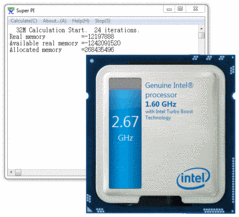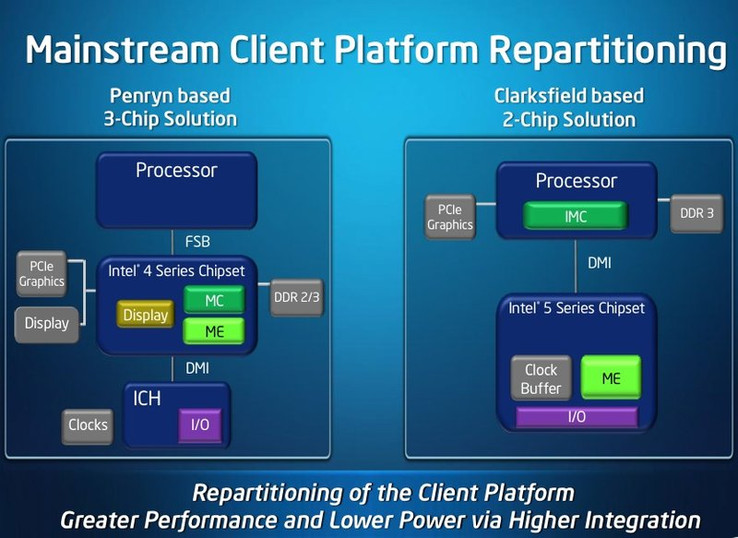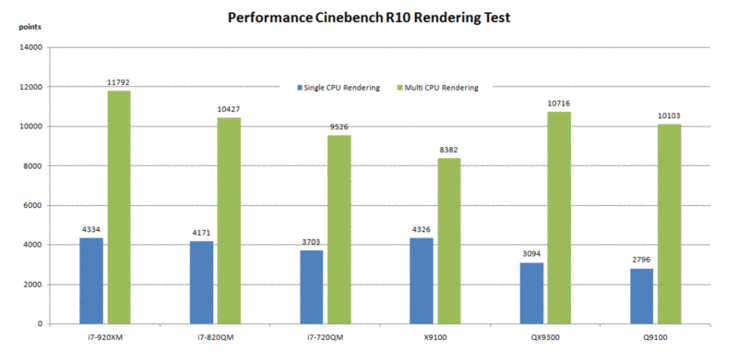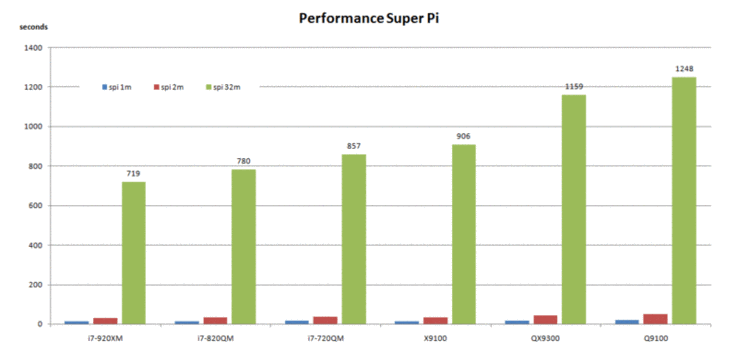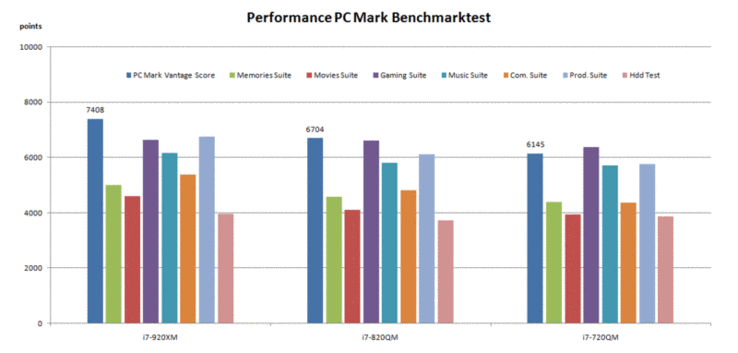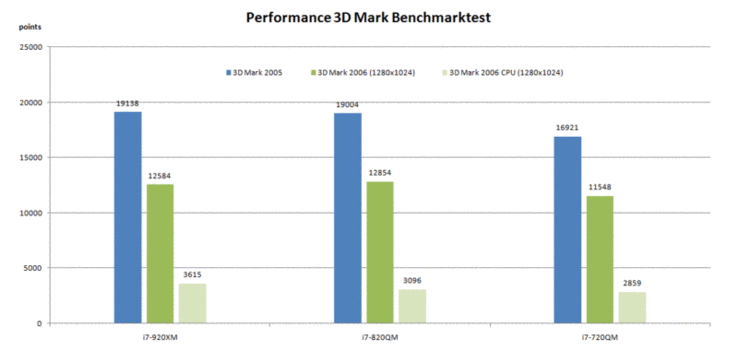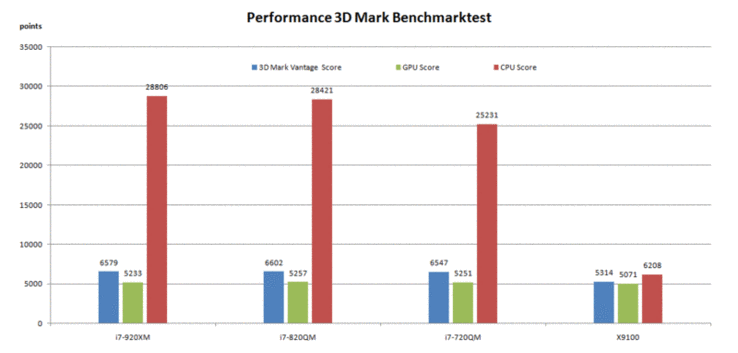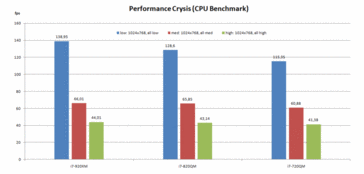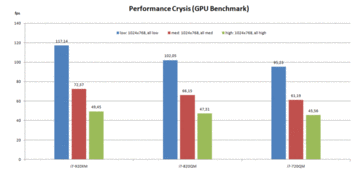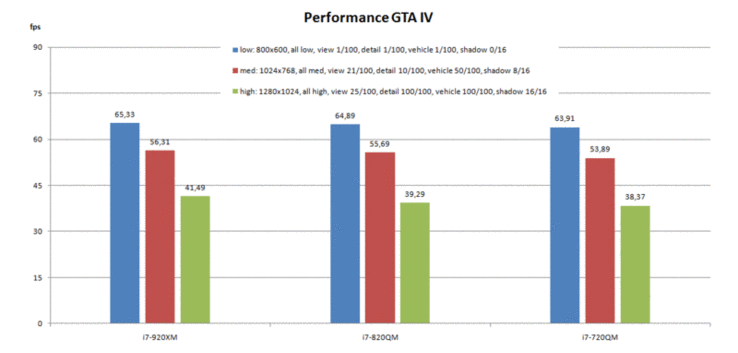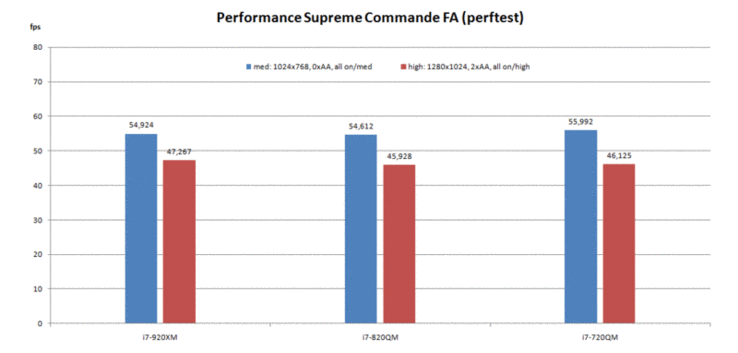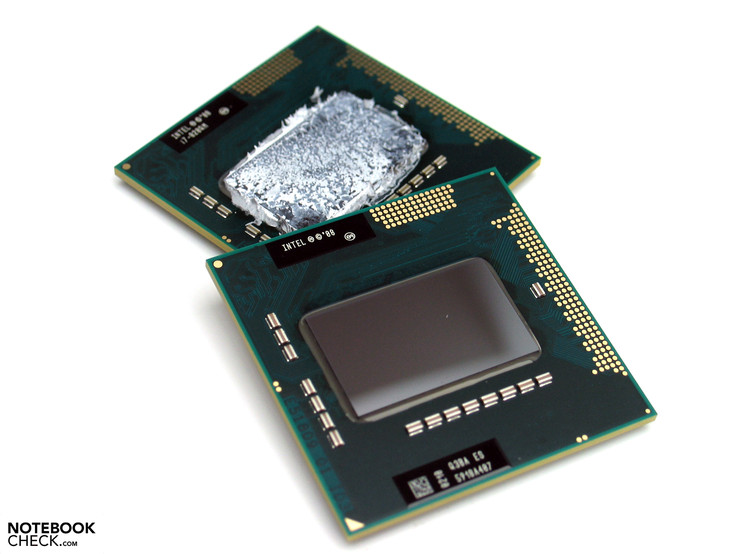Review Intel Core i7 Processor "Clarksfield"
Tick-Tock-Tick-TOCK.
The Nehalem architecture for the desktop field has already existed for some time. Now mobile users will have the benefit of i7 processors that bring a whole range of innovations in comparison to the already existing Intel Core 2 Quad CPUs. The processor will, for instance, integrate single functions that have been left to the chip set up till now and a high clock rate is also coming back into fashion - thanks to turbo boost.
As usual, we are providing an overview of the new chips and a first performance comparison test with the launch of a new processor generation. As before, the Penryn 2 core chips (Core 2 Duo) dominate in the technical data of current notebook models though, and that will also stay that way for the time being. The new Clarksfield chips will probably primarily relieve the existing Intel Core 2 Quad CPUs, as they unite the advantages of two and four core chips and are on about the same price level. Therefore, the processors will principally be found in high-end notebooks of the business, multimedia and gaming division.
The Test System
A mySN XMG7.c notebook, based on Clevo's W879CU barebone, serves as a test platform. The high-end gamer, with an Intel Express PM55 mobile chip set, Nvidia GTX 280M graphic and 1333MHz DDR3 RAM, bids an efficient platform to present the new Intel Core i7 in the right light.
As soon as it's available, we will naturally dedicate this notebook a comprehensive review.
A basic precondition for the test is good accessibility of the single hardware components for a quick CPU exchange. The mySN XMG7.c has the best requirements in view of maintenance and upgrading. After removing a large maintenance cover on the devices bottom side, you have access to all vital components. The CPU exchange can also be executed equally unproblematic. These lay unfettered on the base after disassembling the fan and the cooling body and can be replaced with a compatible chip.
A pre-sample of the mySN XMG7.c (W879CU) notebook that is optically close to the sold device, is the base of the following test. Changes can't be completely excluded, though. This equally applies to the technical configuration of the prototype:
- Mobile Intel PM55 chip set
- Intel Core i7 / Extreme CPU
- Nvidia Geforce GTX 280M 1024MB GDDR3
- 17.3“ LED FullHD Glare TFT
- 4GB DDR3 RAM 1333 MHz (max.8GB)
- 2x Seagate Momentus 500GB/7200U (ST9500420AS) RAID 0
- Price: Starting at 1679 Euros, depending on the selected CPU and configuration
Intel Core i7 Key Data
The lithographical manufacturing process in a 45 nanometer technology has also remained unchanged to the Penryn CPUs. This will first change at the beginning of next year, when Intel turns to the 32 nanometer technology with the Arrendale CPUs and thus makes the next step (tick) in the development of their processors. Until then, only two-core processors in 32 nm technology will be manufactured. This means that we will have to be satisfied with the current 45 nm Clarksfield chips for a while.
The most important, vital characteristic of the new mobile Core i7 is, as already in the Core 2 Quad chips, the processor architecture has four computing cores (now a real quad-core design and not two dual-core CPUs), however simulates four further "threads" thanks to hyper-threading and therefore can score especially in multi-core optimized applications. This can be seen well in Windows Task Manager, for instance, as it visualizes the load of the single cores.
A major problem of the current Core 2 Quad chip was its comparatively low basic clock rate of the single cores. The Q9000 chip only ran with 4x2.0 GHz, the scarcely found Q9100 with 2.26 GHz and the QX9300 chip, with a steep price of over 1000 dollars, merely with 2.53 GHz. Especially in current games, and also various, not multi-core capable applications, the quad-cores were inferior to the significantly cheaper, but higher clocked dual-core chips. For example, Alienware recognized this problem and offered the M17x as the flagship of the product range with an overclocked QX9300 CPU (@ 3.06 GHz) ex-factory. This, however, was only possible due to the according cooling reserves of the notebook.
The average consumer may now look forward to the Core i7's integrated turbo boost function, though. Hence, every CPU has a certain bandwidth in view of clock rate, whereas the CPU independently adjusts to the demanded performance under consideration of the system's max. TDP (45W and 55W i7-920XM) and the cooling performance.
The mentioned bandwidth turns out considerable. The i7-720QM CPU clocks up from 1.6 GHz to a maximum of 2.8 GHz, which equals the level of a P9700 or a T9600 Core 2 Duo Penryn CPU. However, this only happens in the "best" case, which is as long as only one core is working to capacity. If, for instance, all four cores are called upon at the same time (as in multi-core rendering), the chip runs with an accordingly lower clock rate. Because this permanent adjusting happens autonomously, the user benefits from the consistent maximum possible performance or the maximum energy savings.
Talking about energy saving: This doesn't only take place with the comparatively low basic clock rate when a core isn't processing, Intel now integrates the function of switching cores that aren't required completely currentless. Aside from the obvious savings potential due to these measures, a further benefit results: Due to the constantly decreasing structure sizes (45 nm) the increasing problem of leakage currents can be kept within a limit.
Although the technical CPU data – 720QM/820QM TDP 45W, 920XM TDP 55W – are on a level with the previous Core 2 Quad chips, the new Core i7 architecture should stay under that of its Penryn counterparts in relation to power consumption, due to the above mentioned measures.
A few facts about the new Calpella architecture: The existing separation of the chip set in North and Southbridge has been abolished. The CPU will integrate the controller for the graphic card and RAM. Therefore another previous bottle neck is omitted with the frontsidebus. Further information about the new Core i7 CPU can be found here.
Here is an overview of the new processors and comparisons with Intel Core 2 Quad chips and the X9100 Penryn two-core CPU.
| Name | Clock Rate | L2/L3-Cache | TDP | Price(Intel, 1k units) |
| Core i7 920XM | 2.0-3.2 GHz | 1MB / 8MB | 55W | $ 1054.- |
| Core i7 820QM | 1.73-3.06 GHz | 1MB / 8MB | 45W | $ 546.- |
| Core i7 720QM | 1.6-2.8 GHz | 1MB / 6MB | 45W | $ 364.- |
| Core 2 Exteme X9100 | 3.06 GHz | 6MB / - | 44W | $ 851.- |
| Core 2 Extreme QX9300 | 2.53 GHz | 12MB / - | 45W | $ 1038.- |
| Core 2 Quad Q9100 | 2.26 GHz | 12MB / - | 45W | $ 851.- |
| Core 2 Quad Q9900 | 2.0 GHz | 6MB / - | 45W | $ 348.- |
Synthetic Benchmarks
Cinebench R10
One of the most exiting tools for comparing the CPU performance in single and in multi-core mode is the benchmark program Cinebench R10. It's possible to simulate rendering an image with either one or all four cores as selected with this program. The CPU as a quad-core chip with turbo boost function naturally stands in direct competition with the efficient dual-core chips and the existing Intel Core Quad CPUs.
In the CPU single rendering test, the i7-920M CPU achieved 4334 points and could even top the X9100 CPU slightly with that. The performance in the GPU multi test was equally impressive: The 920XM chip could even exceed the results of the QX9300 CPU by around 1000 points with 11792 points. The immense benefit of the new i7 chip already becomes evident here: The processors unite highest performance in the use of only a few cores with the advantage of multi-core chips.
Even the 720QM chip, as the "weakest" solution of the current mobile i7 overture scores an excellent result of 3703 points in the single core test (comparable to T9900, T9800) and can thus also exceed the QX9300 CPU. 9526 points in the multi-core test is a bit less than the QX9300 or the Q9100 CPUs can achieve, for example, but the 720 QM CPU moves on the highest level here.
The CPU has an impact on the Cinebench R10 OpenGL Shading test, as well. The 920XM chip achieved 5450 points, the 820WM 5114 points (-6%) and finally the 720WM 3725 points (-32%). Professional CAD users should thus stick to the more efficient chips in order to achieve a maximum of performance.
Super Pi
A further proof of the Intel mobile i7 chip's efficiency is made by the comparison of Super Pi Benchmark test. The value Pi is calculated to a pre-defined specific accuracy, whereas multi-core technology isn't supported. The result also shows that the previous low clocked Intel Core 2 Quad chips especially lose ground here, which isn't surprising.
The Core 2 Extreme X9100 CPU does its job significantly faster with 3.06 GHz. However, even the 720QM chip can't beat the currently most efficient two-core CPU and undercuts it by around 50 seconds at calculating Pi to 32 million decimal digits. The 820QM and the 920XM chips bid an even greater time gain.
The differences are significantly lower or rather barely have an impact when looking at the results of the test categories 1m and 2m. The new i7 chips could definitely use their superiority in complex scientific and technical calculation methods.
PC Mark Vantage
Finally, we put our prototype to a comparison with the current PCMark Vantage from Futuremark. This checks single application scenarios and evaluates the system's total performance.
That the overall results in sequence correlate to the classification of the new i7 chip isn't very surprising. The same tendency can be seen in alomst all segments comparing the single results with each other, whereas the CPU's influence is of course weighted more or less strongly in each test procedure.
Even if we didn't use a dual-core or the previous Core 2 Quad chips in our mySN XMG7.c prototype, the advantages of the i7 chip can be concluded just the same due to the results above.
3D Mark 2005 / 2006
Whilst the previous tests mainly focus on the CPU's performance, the 3DMark tests primarily assess the system's performance in graphic-biased applications and games.
Also, a comparatively strong CPU influence on the overall result can be observed in the 3DMark 2005. This can also be applied to older games, where an efficient CPU can very well contribute to a considerable improvement in performance.
It looks different then in the 3DMark 2006 benchmark, as it can be observed in the shrinking of the overall result's bandwidth. Striking is: the 820QM CPU scored even a bit better in the overall rating than the stronger 920XM XPU in an identical test system. The difference should however be within the possible dispersion of results. The i7-729QM is last in line and achieves ca. 90% of the maximum performance (820QM).
The separately shown CPU score of the 3DMark 2006 benchmark test certifies the 920XM a bonus of about 600 points in comparison to the 820QM CPU (+17%) and ca. 800 points in comparison to the 720QM CPU (+26%).
3D Mark Vantage
The comparison with the current 3DMark Vantage benchmark test turns out very similar. The overall results of all three i7 chips are practically identical, or rather are within a possible dispersion that has to be taken in account.
The achieved CPU scores follow the ranking of the Intel chips as expected. The single high absolute results are due to the activation of PhysX in the test.
Generally, the test already indicates to a possible verdict: No matter which CPU you select, the impact on performance in modern games stay rather minute.
Gaming Performance
Now, it's up to a few games to check and maybe correct the cognitions of the executed synthetic benchmarks.
As usual, we use current games that are especially characterized by their high demands on the CPU. The effect of the processor on the overall performance naturally turns out lower in games with a lower expected CPU load. Therefore, all tests are to be understood as representative of the best possible improvement of current games with the use of an efficient CPU.
Crysis
As usual, we'll check the performance of the performance-hungry first-person shooters via the game integrated CPU and GPU benchmark tests. The best result of four run-throughs is applied (average fps). A resolution setting of 1024x768 pixels and a selective presetting of high/medium/low are used for benchmarking.
Basically, in both benchmark variants (GPU, CPU) it can generally be observed that the CPU's influence decreases whereas the graphic demand increases in form of the chosen detail level. As the 920XM CPU still has a plus of ca. 20% in the CPU benchmark in low details, this decreases in medium details to around 8% and in highest detail level even to 6%. The result is similar in the GPU benchmark test. The 920XM CPU tops the 720QM chip by 23% in low details. Hence there is only +8% to be elicited.
In comparison of the 920XM CPU to the 720QM CPU we are talking about an advantage of around 4 frames in high details in the GPU benchmark test and around 3 frames in the CPU benchmark test in absolute numbers.
If this result is compared with, for instance, a strong dual-core processor (X9100 in the Clevo M980NU with a GTX280M), it positions itself with 106/67/45 fps in the Crysis CPU test at about the level of the 820WM and the 720QM CPU depending on the chosen setting. The X9100 chip has a slight advantage at low details that the 920XM CPU, however, can't achieve.
GTA IV
GTA IV was prone to critique at its release date especially because of the immense hardware demand and in particular in view of CPU. Fortunately, you can rely on the engineers and you can now benefit from a considerably more efficient processor than it was possible about a year ago.
For our comparison, we once again used the game integrated benchmark test and checked three different settings.
Result: Unlike Crysis, the differences between the single CPUs of the tested settings turned out much lower. Thus, the 920QX and the 720QM CPUs were merely around 1.5 frames, or rather 2%, apart in low details. The results in a medium detail level (4%) and highest chosen settings (8%), or rather 3 frames, also confirm this.
Looking back once more on our comparison model, the Clevo M980NU with an X9100 Core 2 Extreme CPU and GTX 280M graphic stays significantly far behind the results of the new Core i7 chips with 48/47/33 fps in the benchmark test, even if a certain deviation is considered because it's not the same test platform, although the configuration is similar.
As already assumed, multi-core CPUs can score in GTA IV.
Supreme Commander – Forged Alliance
Finally we examined the CPUs with the strategy game SupCom FA. The integrated performance test also served as basis for our results. Two possible variants were tested, representative for medium and high graphic demands.
Brought to the point, the benefit of the 920QM CPU vanishes almost completely. The assessed results were only around 1 frame apart, which also can be ascribed to a possible dispersion of results.
Verdict
Two basic statements can be extracted from the tests we made. First: the new mobile Intel Core i7 chips unite all advantages of a high clock rated dual-core CPU with the multi-core bonus of a quad-core processor. No matter which application is executed or if it supports multi-CPU technology or not - all i7 chips are always found in the top field in view of performance, thanks to the turbo function.
Secondly: the impact of the chips in games, as already could be seen in our numerous, previous CPU tests, turned out comparatively minute. Even games renown as CPU-biased barely made a difference between the respectively used i7 CPU. The bandwidth of the possible performance increase remain within the one-digit percent field and within only a few frames.
The new i7 processors can also score in comparison to strong dual-core chips, as the 720QM and 820QM chips show about the same performance as a X9100 Dual Core CPU in Crysis. The benefit of the new quad-cores turn out even more evident in multi-core support.
Surmising this, the i7 720QM CPU is likely to be the winner of the value for money competition, except for a few specific applications. Intel lists the chip currently at 364 dollars. With this, the CPU has about the same price as the P9700 CPU or the P9600 CPU with 2.8, respectively 2.66 GHz. Thanks to the boost function, the chip of both two-cores hasn't got any disadvantages in single-core optimized applications but moreover bids the big benefit of supplying of four physical cores for simultaneous applications.
The only stumbling block of seeing the new i7 chips very soon in many notebooks would be the comparatively high TDP value of 45W. This will restrict the use to efficient 17 inch notebooks and larger for the time being. However, a few manufacturers have also announced using the i7 CPUs in compacter 15 inch notebooks. Found in, for instance, Alienware's M15x, Clevo's W860CU but also HP's Envy 15.
Many thanks to Schenker-Notebook, who kindly provided us with the test device. You can configure and purchase it here, as well.





